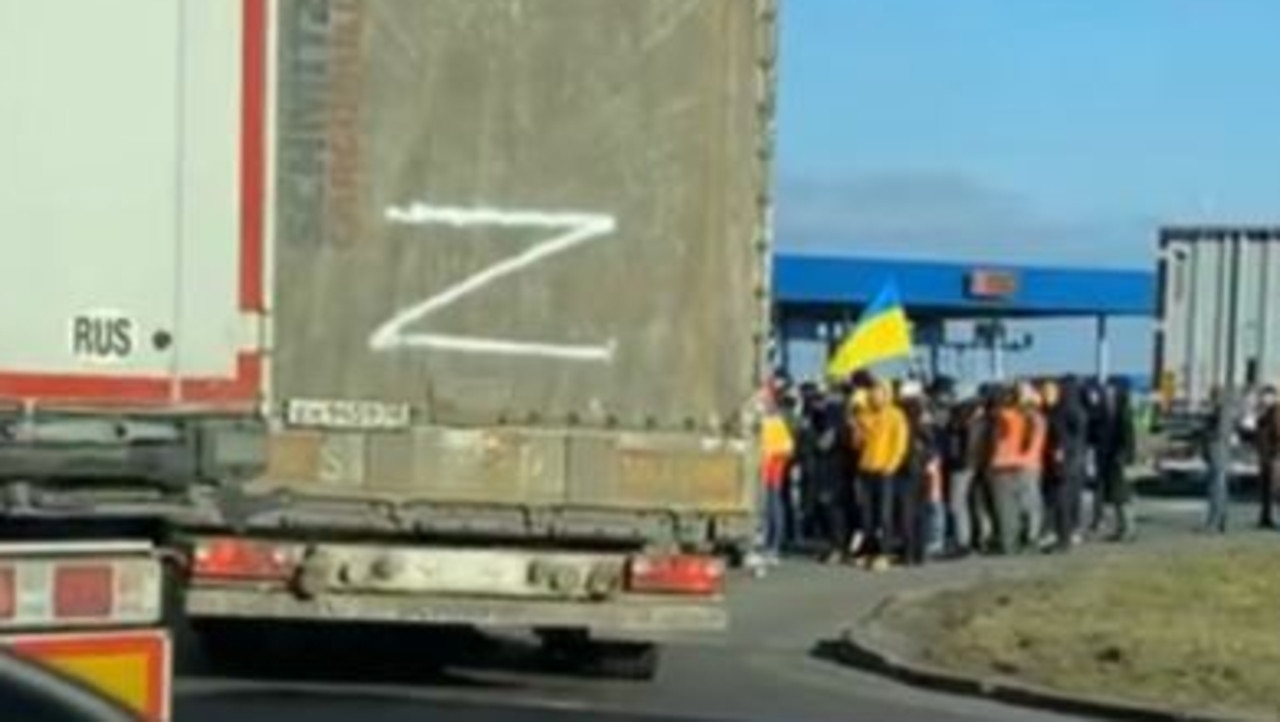Incredible efforts at Polish border to block Russian convoy of trucks
Wild footage from the Polish border is showing the fierce attempts made by a small group of people to block Russian forces from moving.
Wild footage from the Polish border is showing the fierce attempts made by a small group of people to block Russian forces.
The group, understood to be a few dozen Ukrainians living in Poland, have been blocking a huge convoy of trucks on the key road link from Poland to Belarus.
Some of the trucks have Russia’s infamous ‘Z’ symbol spray painted on them after drivers “began drawing” them on trucks and “threatened to crush people”, activist Iryna Zemlyana claimed.
The trucks, loaded with goods including “military secrets”, came to a stop at the Kukuryki checkpoint at the Polish-Belarusian border on Sunday night. Since then, the queue has been growing and growing.
The traffic jam is now at least 28 kilometres while local roads are also reportedly clogged after drivers attempted shortcuts in an attempt to find a way out.
The Australian’s Europe Correspondent Jacquelin Magnay reports “more than a thousand semi-trailers” are involved in the chaos.
“When we got to the front of the long queue – a 20-minute drive including past a police checkpoint where officials demanded to see identification – one of the first two semi-trailers that had been stopped was marked with the Russian military “Z’’ symbol in white on its rear door,” Magnay wrote.
“That truck driver was nowhere to be found.”

Footage posted by activist Żenia Klimakin and reposted by Ukrainian independent news agency Euromaidan Press shows just how long the queue stretches. The activists say that while sanctions have been imposed on air cargo, the same had not been applied to road transport, and prior to the blockade thousands of trucks were transporting supplies to Russia assisting in the war in Ukraine.
“We believe that transport from the occupying country should not enter the EU territory,” Mr Klimakin said, posting daily updates as the queue stretches.
The incredible feat is thanks to a small group of 40 expatriate Ukrainians, according to The Australian.
Long queues of trucks with Russian and Belarusian registrations were noticed by Poles crossing🇵🇱–🇧🇾Kukuryki border. Drivers' replies about cargo were "military secret", "food, medicine, equipment"; trucks were loaded in Germany🇩🇪despite sanctionshttps://t.co/WvRjOEq0xmpic.twitter.com/UCWn7TNG2p
— Euromaidan Press (@EuromaidanPress) March 12, 2022
Russia’s forces had earlier focused on eastern and southern areas of Ukraine — home to more ethnic Russians — but in recent days have moved to the country’s centre, striking the city of Dnipro, and now to the west
While western Ukraine has largely been spared so far, Russian air strikes over the weekend carried the war deep into the west, killing 35 people and wounding 134 at a military base near Yavoriv, outside the city of Lviv — which is dangerously close to the frontier with EU and NATO member Poland.
It was the westernmost attack by Russia so far.
“We wanted and we want to co-operate peacefully, to co-operate between Poland, Ukraine and Lithuania and with all our eastern neighbours,” Poland’s prime minister Mateusz Morawiecki said overnight.
“We have only those intentions, but if somebody comes brutally into our home, into our homes – destroys, robs, murders, rapes, then we are determined to do everything to counteract that barbarity.”
Ukrainian President Volodymyr Zelensky urged NATO in a video address to impose a no-fly zone over his country and warned it could only be a “matter of time”.
“If you do not close our sky, it is only a matter of time before Russian missiles fall on your territory, on NATO territory, on the homes of NATO citizens.”
âš¡ï¸Ukrainians continue to block occupiers' trucks on the border with Poland
— Ukraine 4 Freedom (@uawarinfo) March 14, 2022
For the third day, Ukrainian activists have been holding back the movement of russian and Belarusian trucks on the Polish-Belarusian border. pic.twitter.com/9nxw9M7qvW
Mr Klimakin revealed in his conversation with Russian drivers, “activists talk to drivers, explain the reasons for the action, talk about the war, victims, destroyed cities, try to share their personal stories about how Russia destroys everything and everyone on its way.
“There were about a hundred such conversations for sure. What have we heard from drivers?
“Threats of physical disorder. I even had to call the police asking to calm down some of the big ones.
“Explanation that they don’t care what the Kremlin does, they are not interested in politics.
“No one said that they were strictly against the actions of the Kremlin. Apparently there are people in that caravan van who are ashamed and hurt, but we haven’t met them. None of them.”
Secret meetings in Poland
It comes as US Vice President Kamala Harris will travel to Poland on Wednesday to discuss how to provide “military assistance” for Ukraine, White House officials said, hours after Washington rejected Warsaw’s offer of Soviet-era fighter jets.
The trip was planned before Poland took the United States by surprise on Tuesday by offering to send its Mig-29 jets to Ukraine via a US air base.
Washington rejected the proposal, with Pentagon spokesman John Kirby saying the prospect of the jets flying from a US-NATO base “into airspace that is contested with Russia over Ukraine raises serious concerns for the entire NATO alliance.”
Harris will meet with Polish President Andrzej Duda and Prime Minister Mateusz Morawiecki on Thursday, according to US officials who requested anonymity.
When asked about the fighter jets, a White House official did not address the subject directly.
“We have been in dialogue with the Poles for some time about how best to provide a variety of security assistance to Ukraine. And that’s a dialogue that absolutely will continue up to and as part of the vice president’s trip,” she said.
Canadian Prime Minister Justin Trudeau, who is visiting Poland, is also expected to meet Harris.
— with AFP




